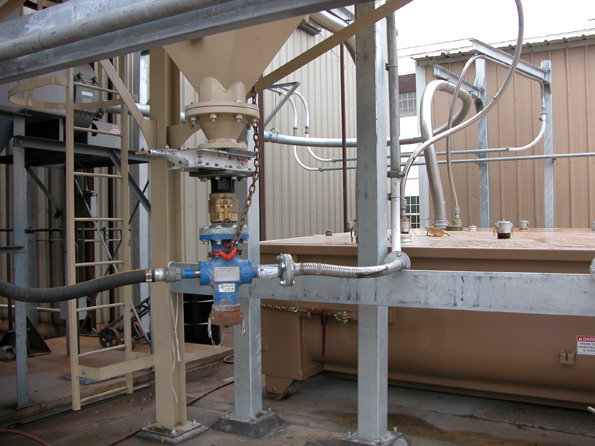
Conveyig Abrasive Dust (Continued)
That leaves positive pneumatic conveying into the container as the preferred option, especially since the destination containers vent back to the dust collectors. The possible use of rotary valves, or airlocks, are profoundly unsuitable for this application for three major reasons:
a) Blowback and fugitive dust are inevitable with airlocks - unacceptable with a hazardous powder
b) The garnet sand and steel shot are extremely abrasive. Even with initially tight rotor/housing clearances to minimize airlock blowback, erosive wear will quickly increase these gaps, increasing blowback, which, in turn, will accelerate wear and create more dust leakage.
c) The abrasive powders will cause frequent bearing, seal, and airlock failures.
The engineering team assigned to these projects - including both consulting engineers and the dust collector manufacturers - chose wear-treated Fox venturi eductors. Because eductors create a "vacuum" at the point of powder ingress - there is no leakage and no blowback. Because they have no moving parts - they can convey these dense, abrasive, and hazardous materials maintenance-free.
This application essentially duplicates many, many successful eductor installations made in the 1990s at foundries in the Midwest - as shown in attached photo. These foundries - often located near homes in small towns, had zero tolerance for blowback and dust leakage - and also conveyed their foundry dust into roll-off containers ( called gondolas ). Many such systems have been in operation for ten years or more.
Attachments
■
Conveying Abrasive Dust (Continued)
Fox Valve supplied matched blowers to drive sets of eductors - with one small blower simultaneously driving two eductors under a two cell dust collector. Eductor design automatically „balances‰ air flow to each eductor - which remains constant whether the eductor is, or is not, conveying any powders. Shorter convey systems could use small, side channel blowers running at 3 psig, while longer convey lines used pd blowers supplied by Fox running at 6 - 8 psig. Of course, compressed air is never used to drive venturi eductors.
The engineering contractors selected Fox eductors with a standard ŒClean Out Port‚ - which enables quick and easy access to eductor internals, without disconnecting the eductor. This is to address clogging that may be due to unexpected foreign objects, debris, or clumps that may enter the dust collectors.
For more information, please visit:

href="https://edir.bulk-online.com/profile/1806-fox-venturi-eductors-fox-valve.htm" target="blank">https://edir.bulk-online.com/profile...-fox-valve.htm

href="http://www.google.com/search?client=safari&rls=de-de&q=fox+valve+site:bulk-online.com&ie=UTF-8&oe=UTF-8" target="blank">http://www.google.com/search?client=...UTF-8&oe=UTF-8
Attachments
■











Conveying Abrasive Dust
Conveying Abrasive and/or Hazardous Dust to Roll-Off Containers with No Moving Parts
This large industrial equipment refurbishment facility in Texas needed to to convey steel shot and garnet sand (from metal blasting operations) from seventeen dust collector outlets and convey the dust to roll-off containers. The used sand and shot, which also carries debris from a metal blasting process, is considered a Class 9 Hazardous Waste and is delivered to roll-on/roll-off containers rated for hazardous materials. The powder/dust flow rate from each dust collector cell is just 100 or 250 lbs/hr - and convey distances to the roll-off containers varies from about 70 to 150 ft with four or six bends.
Bulk densites are: steel shot 100 - 120 lbs/ft3; garnet sand : 90 - 100 lbs/ft3
The compelling design consideration for the engineers on this project was the elimination of fugitive dust, leakage, or blowback from the (17) feeders used to convey from each dust collector outlet. Conveying had to be clean, reliable, and dust free.
When conveying from dust collectors - many system designers may consider vacuum, or negative conveying systems to be the obvious solution - since a vacuum system would "pull" a deeper vacuum that in the collector - and pull material out with no chance of leakage. However, since the destination is a series of ever-changing roll-off containers, mounting, or connecting the necessary vacuum receiver atop each container would be impractical.
Attachments
fox_1 (JPG)
■